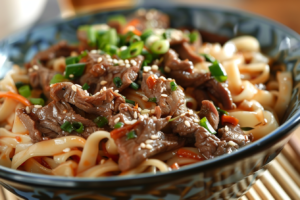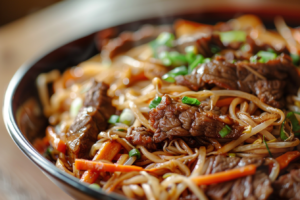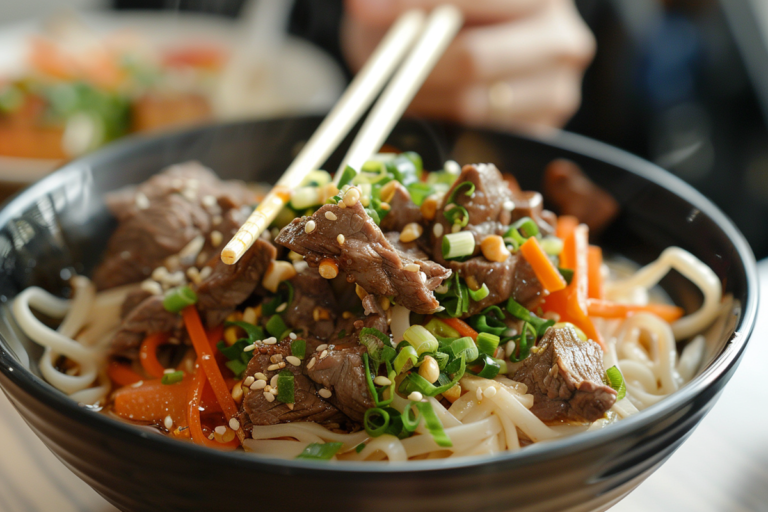Before we delve into the heartwarming world of Beef and Noodles, let’s set the table for what’s to come. This dish, a staple in many households, is not just a meal; it’s a comforting embrace in the form of tender beef and hearty noodles. In this article, we’ll explore the traditional recipe, dive into its variations, and offer tips to perfect this beloved dish. From the history behind it to the best ways to enjoy it, get ready to satisfy your culinary curiosity—and your appetite!
Classic Beef and Noodles Recipe
Recipe Overview
The dish we’re spotlighting today, Beef and Noodles, stands out with its simple yet profound flavors that echo the comfort of home cooking. This recipe, known for its hearty embrace, features succulent beef slow-cooked to perfection, mingled with rich, egg noodles, absorbing every ounce of flavor.
Ingredients and Preparation
For this quintessential comfort food, you’ll need:
- 3 lb chuck roast: Chosen for its fat marbling that ensures flavorful tenderness.
- Salt and pepper: Just enough to enhance the natural flavors of the beef.
- 2 tbsp neutral oil: For searing the beef to a perfect crust.
- Vegetables: Carrots, celery, and onion, finely diced to meld into the savory broth.
- Herbs: Fresh thyme and parsley, tying the bouquet of flavors together.
- 8 cups beef stock: The base of our luscious sauce (quality beef bouillon can also be used for richness).
- 1 lb egg noodles: The perfect carrier for our robust sauce.
Cooking Instructions
- Preheat and Sear: Begin by heating your oven to 350°F. Season the roast generously and sear in hot oil until all sides are beautifully browned.
- Sauté Vegetables: In the same pot, the mirepoix (a fancy word for your diced veggies) gets a turn, softening into a fragrant bed for the beef.
- Braise: Return the beef to the pot, pour in the stock, and let it all come to a gentle simmer. Cover and slide it into the oven. The long, slow cook will pull all the flavors into a beautiful harmony.
- Noodle Time: Towards the end of cooking, remove the beef to rest, then boil the noodles in the same broth, absorbing all that meaty goodness.
Serving Suggestions
Once the noodles are tender and the beef is fall-apart delicious, shred the meat, toss it back with the noodles, sprinkle some fresh parsley, and voila! You’ve got a dish that’s bound to gather everyone around the table.
So, why wait? Grab your apron, and let’s make this dish that promises to be as nourishing as it is delightful! Keep an eye out for the next section where we’ll explore some tasty twists on this classic recipe.
Variations of Beef and Noodles
Regional Takes on Beef and Noodles
Every region adds its own unique touch to this dish, reflecting local tastes and available ingredients. Here’s a table showcasing some popular variations from around the world:
| Region | Variation Description | Key Ingredients |
|---|---|---|
| Midwest, USA | Traditional hearty beef and noodles served with a side of mashed potatoes or green beans. | Egg noodles, chuck roast, carrots |
| Italy | Italian-inspired take using marinara sauce and serving over fettuccine. | Marinara sauce, fettuccine, basil |
| Hungary | Paprikash version with a spicy paprika broth and added sour cream. | Paprika, sour cream, onion |
| Japan | Adapted as a sukiyaki with thinly sliced beef and udon noodles in a soy-based broth. | Udon noodles, soy sauce, mirin |
Alternative Ingredients and Substitutions
For those with specific dietary needs or preferences, here are some substitutions that can keep the dish just as delightful:
| Original Ingredient | Substitution | Reason for Substitution |
|---|---|---|
| Beef | Portobello mushrooms or seitan | Vegetarian or vegan diets |
| Egg noodles | Gluten-free noodles or zucchini noodles | Gluten intolerance or low-carb diets |
| Beef stock | Vegetable or mushroom stock | Vegetarian diets |
These substitutions ensure that everyone, regardless of dietary restrictions, can enjoy a version of this comforting dish.
Experimenting with Flavors
Don’t be afraid to get creative and add your own twist to your Beef and Noodles. Whether it’s incorporating a dash of red wine for depth or a sprinkle of fresh herbs for brightness, each addition can transform the dish into something uniquely yours.
By exploring these variations and considering different dietary needs, this beloved dish can be adapted to suit any table around the world. Stay tuned for the next part where we’ll dive into the fascinating history behind Beef and Noodles.
The History of Beef and Noodles
Origins of the Dish
Beef and Noodles is a dish that resonates with the essence of comfort food across many cultures, but its roots can be traced back to the heartland of America. Originating in the Midwest during the early 20th century, this dish was a practical solution for feeding large families a nutritious meal that could stretch the often limited supplies of meat throughout the week.

The dish quickly became a staple, with each family passing down their own version, subtly tweaking the recipe to suit their tastes or the ingredients they had on hand. Over time, the basic recipe of slow-cooked beef served over noodles became embedded in regional culinary traditions, symbolizing home-cooked comfort.
Popularity in Midwestern Cuisine
In the Midwest, Beef and Noodles is more than just a meal; it’s part of a culinary tradition that emphasizes warmth and generosity. The dish is often associated with family gatherings, holiday celebrations, and potluck dinners, where it’s served in heaping portions to ensure everyone feels the warmth of the community.
The preparation of the dish in this region often involves cooking the beef until it is tender enough to fall apart with the slightest touch, mixed with thick, hearty noodles that have absorbed the rich, meaty flavors of the broth. It’s a simple, hearty meal that reflects the practical and resourceful spirit of Midwestern cooks.
Influence on International Cuisines
As people moved and migrated, they took their beloved Beef and Noodles recipe with them, introducing it to new regions and cultures. This led to various adaptations around the globe, where local ingredients and flavors melded with the traditional recipe to create new versions of the classic dish. From the stroganoffs of Eastern Europe to the beef noodle soups of East Asia, the concept of tender beef with noodles has found a place in countless cuisines.
Moreover, the simplicity and versatility of Beef and Noodles have allowed it to remain popular even as dining trends shift towards more modern and sophisticated dishes. It’s a testament to the timeless appeal of comfort food and its ability to bring people together, regardless of their background.
In our next section, we’ll share some essential tips for perfecting your Beef and Noodles, ensuring that every bite is as satisfying as it is delicious. Stay tuned to elevate your culinary skills with some expert advice!
Tips for Perfect Beef and Noodles
Choosing the Right Cut of Beef
Selecting the appropriate cut of beef is crucial for achieving the desired tenderness and flavor in your Beef and Noodles. Here’s a brief manual to assist you in selecting the optimal option:
| Cut of Beef | Characteristics | Best For |
|---|---|---|
| Chuck Roast | Rich in flavor, marbled with fat, becomes tender when slow-cooked. | Slow cooking, braising. |
| Brisket | Leaner than chuck, but with enough connective tissue to tenderize beautifully. | Slow cooking, offers a denser texture. |
| Sirloin Tip | Lean and flavorful, less tender but more economical. | Quicker cooking methods. |
Cooking Techniques for Optimal Flavor

The way you cook your beef can make a world of difference in the final dish. Here are some techniques to enhance the flavor and texture of your Beef and Noodles:
- Searing: Always sear the beef before slow cooking. This process caramelizes the surface of the meat, adding a depth of flavor that simply can’t be achieved otherwise.
- Low and Slow: Cook your beef at a low temperature for several hours. This breaks down the connective tissues and results in melt-in-your-mouth tenderness.
- Deglazing: After searing the beef, use a bit of beef stock to deglaze the pan. This technique lifts the flavorful browned bits from the bottom of the pan, incorporating them back into the dish.
Enhancing the Noodles
The noodles are just as important as the beef. Here’s how to make sure they turn out perfectly:
| Technique | Details |
|---|---|
| Boil in Stock | Cook the noodles in the remaining beef stock to absorb extra flavors. |
| Timing | Add noodles at the end of cooking to avoid overcooking and ensure they retain texture. |
Additional Flavor Boosters
To further elevate the dish, consider incorporating these flavor enhancers:
| Ingredient | Purpose | Usage Tip |
|---|---|---|
| Fresh Herbs | Add brightness and a pop of color. | Sprinkle chopped parsley or thyme before serving. |
| Umami Boosters | Enhance the meaty flavor of the dish. | Add a splash of soy sauce or a spoonful of tomato paste during cooking. |
| Acidic Notes | Balance the richness of the beef and noodles. | Finish with a squeeze of lemon or a dash of vinegar. |
By following these tips, you’ll not only master the art of making Beef and Noodles but also ensure that your dish is a comforting and flavorful delight every time you make it. In the next section, we’ll address frequently asked questions about Beef and Noodles to help clarify any doubts and provide additional insights. Stay tuned!
FAQs About Beef and Noodles
Can I Use Different Types of Noodles?
Absolutely! While egg noodles are traditional due to their ability to soak up flavors and maintain a pleasant texture, there are numerous alternatives that can suit various dietary needs or taste preferences. For a gluten-free option, consider rice noodles or certified gluten-free pasta. Those looking for a lower-carb version might try spiralized vegetables, such as zucchini or squash noodles. Each option brings a unique texture and flavor profile to the dish, so feel free to experiment to find what best suits your palate.
How Can I Make Beef and Noodles in a Slow Cooker?
Making Beef and Noodles in a slow cooker is an excellent way to achieve tender, flavorful meat with minimal effort. Begin by searing the beef in a skillet to develop a flavorful crust. Then, transfer the beef to your slow cooker, adding a mirepoix (diced onions, carrots, and celery), garlic, and enough beef broth to cover the meat. Slow cook for 8-10 hours on low heat, or opt for a quicker method by cooking on high for 4-5 hours. About 30 minutes before serving, add the noodles directly to the slow cooker, allowing them to cook in the rich, meaty broth. This method is perfect for busy days when you want to come home to a comforting meal.
What Are the Best Sides to Serve with Beef and Noodles?
Beef and Noodles is a hearty dish that pairs well with simple, light sides. A crisp green salad dressed with a vinaigrette offers a refreshing contrast to the richness of the beef and noodles. Steamed or roasted vegetables, such as green beans, broccoli, or asparagus, provide a healthy and colorful side that complements the savory flavors of the main dish. For those who enjoy a bit of extra indulgence, a side of crusty bread is perfect for sopping up any leftover sauce.
How Can I Store and Reheat Leftovers?
Leftovers of Beef and Noodles can be stored in an airtight container in the refrigerator for up to three days. For more on how to efficiently prepare and store meals, check out these easy and nutritious recipes for breakfast stuffed bell peppers. To reheat, simply warm the dish in a saucepan over medium heat, adding a splash of beef broth or water to thin the sauce if necessary. This ensures that the noodles do not become too dry and the beef heats through evenly. Alternatively, you can reheat servings in the microwave, covered, stirring occasionally until hot.
Can I Freeze Beef and Noodles?
Yes, Beef and Noodles freezes quite well, making it a great make-ahead meal. To freeze your meal, allow it to fully cool down after cooking, and then move it into containers suitable for freezing. It’s best to freeze the beef and sauce separately from the noodles if possible, as the noodles can become mushy when reheated. Frozen Beef and Noodles will keep for up to 2-3 months. Thaw overnight in the refrigerator before reheating.
Are There Any Tips for Making Beef and Noodles More Flavorful?
To enhance the flavor of your Beef and Noodles, consider the following tips:
- Deglaze the pan: After searing the beef, deglaze the pan with a splash of beef broth or red wine to incorporate the caramelized bits into the sauce.
- Use fresh herbs: Adding fresh thyme, rosemary, or bay leaves during the cooking process can infuse the dish with aromatic flavors.
- Season well: Proper seasoning with salt and pepper at different stages of cooking helps build depth of flavor.
- Add umami: Incorporate ingredients like Worcestershire sauce, soy sauce, or tomato paste for an extra umami kick.
- Finish with freshness: Before serving, stir in some freshly chopped parsley or a squeeze of lemon juice for a burst of freshness that brightens the entire dish.
By addressing these frequently asked questions, we aim to enhance your cooking experience and ensure that your Beef and Noodles is not only delicious every time but also caters to your specific culinary needs and preferences. For those interested in exploring other traditional dishes, check out this comprehensive guide on Hungarian Goulash, another hearty meal that’s steeped in history. In the next section, we’ll delve into the nutritional insights and benefits of this dish, helping you understand its health implications and how to enjoy it as part of a balanced diet. Stay tuned!
